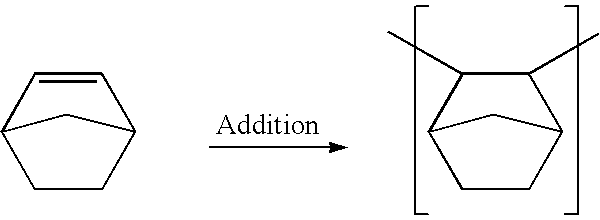Catalyst for polymerization of norbornene
a technology of norbornene and polymerization catalyst, which is applied in the direction of catalyst activation/preparation, physical/chemical process catalyst, chemical/physical process, etc., can solve the problems of poor thermal stability, low yield, and low molecular weight of polynb, so as to improve the activity of the catalyst system of this invention
- Summary
- Abstract
- Description
- Claims
- Application Information
AI Technical Summary
Benefits of technology
Problems solved by technology
Method used
Image
Examples
example 1
[0043] In this experiment norbornene monomer was polymerized into polynorbornene utilizing the catalyst system of this invention. In the procedure utilized 0.0019 grams (8.5×10−6 moles) of palladium acetate and 0.0024 grams (8.5×10−6 moles) of tricyclohexylphosphine were added as solids to 2 grams (0.0213 moles) of norbornene monomer. The mixture was then dissolved into 5 milliliters of toluene. Then 0.0050 grams (2.5×10−5 moles) of dimethyl zinc was added and color changes were observed. Then, 0.036 grams (2.12×10−4 moles) of hexafluoroisopropanol were added to the glass vial and rapid polymerization occurred with a high exotherm. Solid precipitated polymer formed in the vial with essentially 100% of the monomer being polymerized. The toluene solvent boiled off quickly.
example 3
[0045] The procedure utilized in Example 1 was repeated in this experiment except that the dimethyl zinc utilized in Example 1 was not added. Again rapid polymerization occurred and a yield of about 96% was attained.
example 4
[0046] The procedure utilized in Example 3 was repeated in this experiment and this time essentially 100% of the monomer was polymerized into polymer.
PUM
| Property | Measurement | Unit |
|---|---|---|
| Fraction | aaaaa | aaaaa |
| Fraction | aaaaa | aaaaa |
| Fraction | aaaaa | aaaaa |
Abstract
Description
Claims
Application Information
 Login to View More
Login to View More - R&D
- Intellectual Property
- Life Sciences
- Materials
- Tech Scout
- Unparalleled Data Quality
- Higher Quality Content
- 60% Fewer Hallucinations
Browse by: Latest US Patents, China's latest patents, Technical Efficacy Thesaurus, Application Domain, Technology Topic, Popular Technical Reports.
© 2025 PatSnap. All rights reserved.Legal|Privacy policy|Modern Slavery Act Transparency Statement|Sitemap|About US| Contact US: help@patsnap.com



